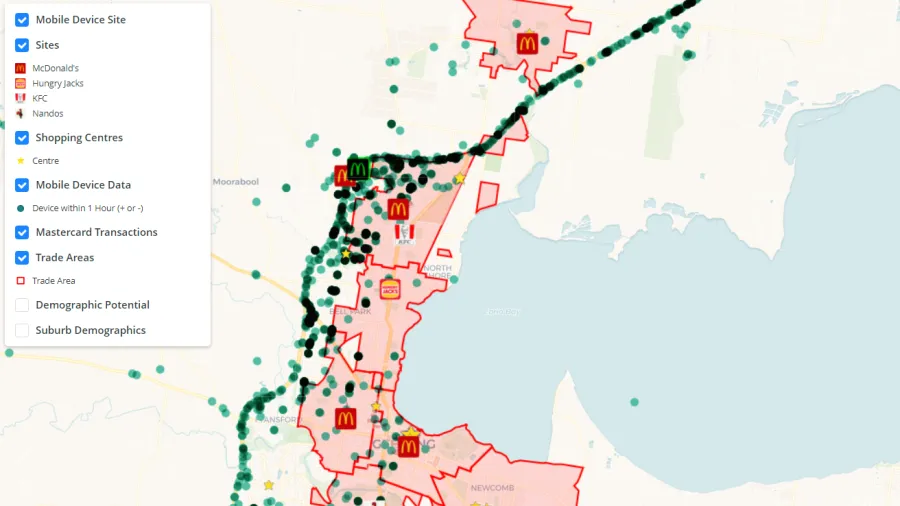
Here's how mobile tech can help QSRs plan their expansion
It can measure pedestrian traffic, profile customer movement, and more.
For a long time, anecdotal experiences and hunches have informed QSRs as they made major expansion decisions. While this may have been a useful strategy on occasion, Australia's market for QSRs has increasingly grown to require deeper insights into the market, the types of locations customers flock to, and their visit habits.
Mobile device data tracking, or MDDT, has opened the door to more meaningful customer insights, simply by monitoring the mobile devices that engage with restaurants. As customers opt to go mobile and contactless, restaurants can unlock a vast data opportunity that can take their businesses not only to new heights but also to the best locations in Australia.
Data analytics company Geotech Information Services supports QSRs as they forecast sales potentials for new restaurants and analyse large network performance. Using MDDT, Geotech also analyses how channels interact during the customer journey, so restaurant owners can take a more proactive approach to property planning.
A unique set of actionable data
In the last few years, MDDT has become a popular solution to understanding customer behavior in-depth and helping businesses identify customer habits, from dine in, to Drive Thru and now understanding delivery potential around a new store.
As a pioneer in the field, Geotech has generated a data set that tracks over 5 million mobile devices across the country. Jeff Vassel, Geotech’s global business development manager, says this is the first data set of its kind that can profile and track consumer movements and retail habits prior to and after visiting a store, allowing Geotech’s QSR clients to better understand the location of customers and non-customers by time of day.
Using local and transient customer movements at different times of the day and the frequency of customer visits to a store, Geotech's MDDT insights can give a client the big picture of how their customers move and gravitate around their location.
For example, restaurants can harness data gathered from mobile devices and identify their average customer’s preferred hours of operations. Store managers can then make an informed business decision regarding whether they should open for 24/7 or close at specific days and times.
“Firstly, like any other data, our view is that there is no one data set that answers all of the questions or solves every problem in relation to retail planning decisions. If there is anything our 25 years' experience has taught us, it is that trapping data is the easy part, knowing what to use and how to use it has proven to be very challenging for some retailers,” Mr Vassel said.
McDonald’s is lovin’ MDDT
For QSRs, understanding their current network is crucial to managing risk, especially as they plan for expansion. Geotech’s cannibalisation analysis helps clients interpret relevant information needed prior to opening a new store. This then allows them to visualise and assess how much of an impact opening a new restaurant will have on the surrounding restaurants which is critical for network planning.
McDonald’s Australia has used MDDT from Geotech to help better understand their customer journey, whether coming from home or transiting past the store to then help predict cannibalisation impacts based on MDDT. Furthermore, the insights derived from MDDT can also show whether the types of people living & working around the store are aligned with the restaurants product offering.
“Geotech Information Services has been an analytics partner of McDonald’s in Australia for over 5 years, assisting to underpin key development decisions with a unique range of predictive analytics and market insights data. They are an engaged and valued partner, particularly in the areas of Sales & Impact analysis. I would recommend any business that undertakes location planning or customer analysis to discuss their requirements with the team at Geotech,” said Josh Bannister, senior director growth platforms, McDonald's Australia.
Geotech’s MDDT has also provided McDonald’s and other QSRs insights into their competitors, customers, and non-customers. The dashboard can present the percentage of potential customer visits and predict loss as well, so that restaurant owners and managers can plan far ahead.
Through graphs, charts & insights, Geotech intuitively presents data to avoid information overload among QSR’s, allowing them to analyse important information at a single glance.
By having a visual of all these factors, QSRs have the opportunity to discuss and create an effective business strategy for achieving desired business goals. Geotech offers a full suite of solutions that helps restaurants adopt mobile device data tracking and integrate it seamlessly into their restaurant operations.
QSRs can then think about business expansion more strategically, beginning with where new stores should be opened, relocated or closed. This would reduce the risk in opening new restaurants and help identify possible cannibalisation. Similarly, underperforming stores can be identified or refurbished to drive sales for better business performance.
All of these considerations combine into one strategy that would create a unique competitive advantage over other QSRs in the market.
Conclusion
It has become extremely commonplace for customers to order food on their mobile devices. Analysing the people who use them, and customers in general, has never been easier with Geotech’s MDDT solution. From measuring pedestrian traffic to profiling customer movement, to generating customer area maps, MDDT is a cutting-edge solution that QSRs should not pass up on.
























